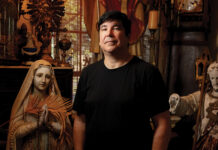
When you’re heading out from Point Clear in a boat, the Middle Bay Lighthouse first appears as a gray bump on the horizon. Gradually, its distinctive silhouette reveals itself as a most curious structure. Compact and hexagonal, it’s almost like a small, oddly shaped house on stilts, and that’s essentially what it was for the men who served as lighthouse keepers around the turn of the last century. Like many other boaters, Doug Terreson finds it captivating. As he cruises a bit closer, he’s likely to break into that warm smile that anyone who meets him remembers.
Terreson has enjoyed the feeling of being on the water for as long as he can remember. Since 2008, our Eastern Shore has provided him an easy escape from the hectic, high-stakes world of global finance in which he was a star player for several decades. Out on Mobile Bay, he can’t help but think of his great-grandfather, a Russian immigrant who served as an attendant on the lighthouse for about 15 years starting in 1890. Sometimes a glimpse of the picturesque beacon triggers the only image of his ancestor that Terreson has ever seen: the faded photograph of James Terreson (the surname he Americanized from Terestchenko) shows him officially attired in a dark uniform with a “K” on either lapel that stands for “Keeper.”


RIGHT: James Terreson, former lighthouse keeper and ancestor of Fairhope’s Doug Terreson.
“I do get a flutter every time I see the lighthouse,” Terreson says from his inconspicuous office space just off Scenic Highway 98. At the age of 63, he’s adapting to a more relaxed pace of semi-retirement. After being consistently rated as the top petroleum industry analyst for many years running on Wall Street, he eased away from the corporate world in 2021.
Not everyone he worked with realized it, but for the last 12 years of his celebrated professional life, he’d been doing it remotely from Point Clear. While his typically Ivy League-educated colleagues were hollering at cabbies or dealing with daily drama on New York’s subway system, Terreson was leisurely making a two-minute commute from, as he likes to say, his house near the first hole of the Lakewood Golf Club and his office near the sixth. “I believe that working from here added years to my career because I didn’t have all the stress and pressure of day-to-day life in New York or driving in from Connecticut for an hour each way,” he says.
His childhood home in Mississippi was close to the Pascagoula River, which became a literal launching pad for his lifelong love of outdoor activities. He describes boating, fishing and water skiing as a way of life rather than occasional diversions. “Almost every weekend, we’d head out to Horn Island or Petit Bois Island,” he says.
His father was an industrial engineer at Ingalls Shipbuilding, and his grandfather ran a busy machine shop. His mother, a native of Laurel, Mississippi, had an impressive work ethic of her own. “She had four kids within six years, completed her degree at night and became an executive for the Guided Missile Defense System for the Navy,” he says, “and she still made sure we were all in church every Sunday.”
Terreson’s early fascination with the oil and gas industry led him to study petroleum engineering at Mississippi State University. After college, he worked for three-and-a-half years on drilling platforms in the Gulf of Mexico. Figuring in his natural affinity for numbers, he made a calculated left-turn move toward the field of finance, enrolling at Rollins College in Winter Park, Florida, to get his MBA. From there, a quickly rising career with investment bankers Morgan Stanley and, later, Evercore ISI, thrust him onto the world stage as a highly influential analyst.
As he writes in his new book, “Can’t Deny It,” his unusual combination of financial savvy and hands-on experience as a directional drilling specialist on offshore rigs helped him gain the trust and ears of industry leaders. For years, he authored reports that would have far-reaching effects on their practices and profits. “I basically published research, and when I hit ‘send,’ it would go all over the world to investors,” he says. “If you invested in a mutual fund or hedge fund, I probably advised the manager or his firm on whether oil prices were going up or down and which were the best energy stocks to buy.”
His market predictions were typically on the money, and some were undeniably historic. One example is his audacious call in 1998 for the largest energy companies to consolidate into “Super-Majors” to create more value for their stockholders. Two by two, they took his advice, and it set off a domino effect that reshaped the industry.
“Within six months of writing my report, the BP-Amoco merger was announced, and it was the largest merger in Wall Street history at the time,” he says. “Four months later, Exxon and Mobil followed suit to form the world’s largest company, and soon after, Chevron and Texaco merged, along with several others. This wave of consolidation marked the most significant strategic transformation in the energy sector since the breakup of the Standard Oil Trust in 1911.”
Other authors have written about Terreson’s achievements, but he wanted to present his experiences — including his unconventional rise to the top — from his own perspective. Though much of the book offers insider looks at business dealings, there’s enough personal content to show that his competitive spirit reached into his downtime, too. Readers learn, for instance, that the phrase that provides the book’s title also was the name of his prize-winning boat. He tells a remarkable tale of how he, his captain and a scrappy crew of teenagers defied conventions to take first place in a prestigious bill-fishing tournament.
His son, Todd, was part of that team, and he now works for Conoco-Phillips after graduating from Baylor University. Terreson pridefully mentions that his daughter, Virginia, is working on her master’s degree in nursing from the University of Alabama at Birmingham and his other daughter, Catherine, will graduate this year from the University of the South in Sewanee, Tennessee. His wife, Edie, was a successful investment fund manager who gave up her own career to focus on raising their family. She is well known in Mobile as chairwoman of Mobile Ballet, is on the board of Prichard Preparatory School and is a former trustee of St. Paul’s Episcopal School and currently serves on its foundation board.
“I’ve kind of had this dual life,” Terreson says. “When I was in New York, I was in the spotlight as this hotshot Wall Street analyst. Here, I was more likely to be known as Todd, Virginia or Catherine’s dad or someone who coached Little League baseball and girls’ softball over the years.”
More than a century later, he loves knowing that his great-grandfather relocated from what is now our state of Alaska to raise a family of his own almost directly across the Bay in the Mon Louis community in south Mobile County. That special connection gives Terreson — a world traveler himself — even deeper emotions about the place where he’s lived for the better part of two decades.
“I just feel like I’m home,” he says, flashing that memorable smile. “I feel like this is where I belong.”





